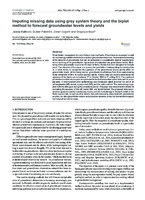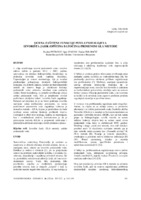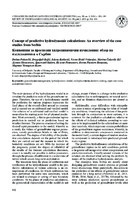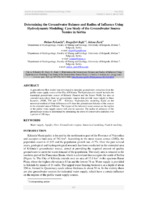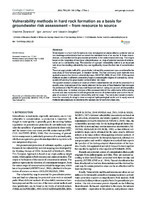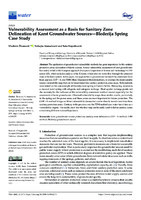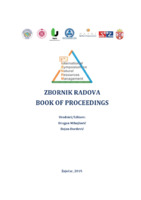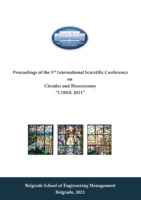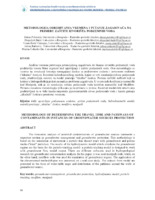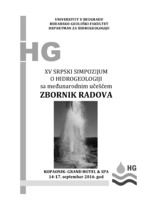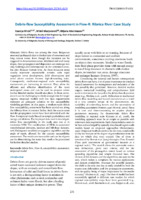Претрага
4920 items
-
Imputing missing data using grey system theory and the biplot method to forecast groundwater levels and yields
Groundwater management is one of today’s important tasks. It has become necessary to seek out increasingly reliable methods to conserve groundwater resources. Dependable forecasting of the amounts of groundwater that can be abstracted in a sustainable manner requires longterm monitoring of the groundwater regime (rate of abstraction and groundwater levels). Monitoring of the groundwater source for the town of Bečej, Serbia had been disrupted for multiple years. The objective of the paper is to assess the possibility of reinterpreting ...Jelena Ratković, Dušan Polomčić, Zoran Gligorić, Dragoljub Bajić. "Imputing missing data using grey system theory and the biplot method to forecast groundwater levels and yields" in Geologia Croatica, Hrvatski geološki institut (2022). https://doi.org/10.4154/gc.2022.14
-
Ocena zaštitne funkcije povlatnih slojeva izvorišta Jasik (Opština Batočina) primenom GLA metode
U cilju utvrđivanja rezervi podzemnih voda i analize uslova zaštite u periodu 2012. i 2013. godine, sprovedena su detaljna hidrogeološka istraživanja na području izvorišta Jasik (opština Batočina). Uspostavljen je sistem monitoringa, čiji je rezultat predstavljao prikupljanje detaljnih hidrogeoloških podataka. Za potrebe analize, izrađen je hidrodinamički model, na osnovu koga je simulirano kretanje podzemnih voda, odnosno, utvrđene zone sanitarne zaštite. Pored navedenog, za potrebe utvrđivanja uslova zaštite podzemnih voda, bilo je neophodno utvrditi podložnost aluvijalne izdani izvorišta Jasik zagađenju. Polazeći ...Rastko Petrović, Igor Jemcov, Dušan Polomčić. "Ocena zaštitne funkcije povlatnih slojeva izvorišta Jasik (Opština Batočina) primenom GLA metode" in Vodoprivreda, Srpsko društvo za navodnjavanje i odvodnjavanje (2014)
-
Concept od predictive hydrodynamic calculations: An overview of the case studies from Serbia
Dušan Polomčić, Dragoljub Bajić, Jelena Ratković, Vesna Ristić Vakanjac, Marina Čokorilo Ilić (2019)groundwater management, hydrodynamic model, multiple-criteria decision making, open cast mine, groundwater source.0Dušan Polomčić, Dragoljub Bajić, Jelena Ratković, Vesna Ristić Vakanjac, Marina Čokorilo Ilić. "Concept od predictive hydrodynamic calculations: An overview of the case studies from Serbia" in National Conference with international participation “Geosciences 2019”, Bulgaria, 2019, Sofia : Bulgarian Geological Society (2019)
-
Determining the Groundwater Balance and Radius of Influence Using Hydrodynamic Modeling: the Case Study of the Groundwater Source “Šumice” (Kikinda, Serbia)
A groundwater flow model was developed to simulate groundwater extraction from the public water supply source of the City of Kikinda. The hydrodynamic model includes the municipal groundwater source of Kikinda (Šumice and the Jezero Well), but also an extended area where there are groundwater sources that provide water supply to three factories: (MSK, TM and LŽT - Kikinda). Hydrodynamic modeling, based on the numerical method of finite differences will show the groundwater balance of the sources in the ...... was developed to simulate groundwater extraction from the public water supply source of the City of Kikinda. The hydrodynamic model includes the municipal groundwater source of Kikinda (Šumice and the Jezero Well), but also an extended area where there are groundwater sources that provide water ...
... of the groundwater sources was determined by hydrodynamic modeling. The impact of industrial groundwater sources on the municipal groundwater source was also assessed. The particle tracking method [12] was used to determine the radius of influence of the groundwater sources over a period of 200 days ...
... wells of the other groundwater sources in the area were specified based on available technical reports [26], as constant values throughout the period. These included the MSK groundwater source, operating two production wells with a total capacity of 54 l/s; the TM groundwater source, using a single ...Dušan Polomčić, Dragoljub Bajić, Jelena Zarić. "Determining the Groundwater Balance and Radius of Influence Using Hydrodynamic Modeling: the Case Study of the Groundwater Source “Šumice” (Kikinda, Serbia)" in Journal of Sustainable Development of Energy, Water and Environment Systems (2015). https://doi.org/10.13044/j.sdewes.2015.03.0017
-
Groundwater resources for drinking water supply in Serbia´s Southeast Pannonian basin
Dušan Polomčić, Bojan Hajdin, Marina Ćuk, Petar Papić, Zoran Stevanović. "Groundwater resources for drinking water supply in Serbia´s Southeast Pannonian basin" in Carpathian Journal of Earth and Environmental Sciences (2014)
-
Dating of alluvial sediments from borehole at the lower course of the Sava river and indications of the connection between their genesis and climate changes in the Pleistocene
David Mitrinović, Jelena Zarić, Oliver Anđelković, Gyorgy Sipos, Dušan Polomčić, Milan Dimkić (2019)This paper analyses the way in which Pleistocene climate change and glaciations in Dinaric Mountains was reflected in the deposition of alluvial sediments in the Sava river Valley, using a case study of Belgrade Groundwater Source (BGS), the largest and most downstream alluvial water supply source along the Sava river. A stratigraphic analysis of the Quaternary sediments from two boreholes on this site, based on sediment dating, lithological members identification, grain size distribution analysis was performed. Comparison with the ...Pleistocene, Alluvial deposits, Climato-lithostratigraphy, Sava river, Belgrade groundwater source, LuminescenceDavid Mitrinović, Jelena Zarić, Oliver Anđelković, Gyorgy Sipos, Dušan Polomčić, Milan Dimkić. "Dating of alluvial sediments from borehole at the lower course of the Sava river and indications of the connection between their genesis and climate changes in the Pleistocene" in Quaternary International, Elsevier BV (2019). https://doi.org/10.1016/j.quaint.2019.09.028
-
Vulnerability methods in hard rock formation as a basis for groundwater risk assessment – from resource to source
Groundwater in a hard rock formation is most endangered at places where a potential source can discharge contaminants that can reach the saturated zone of an aquifer. In these circumstances, an essential tool for groundwater protection is the contamination risk map. This map is based on the integration of two maps: a hazards map, i.e., map of potential sources of contamination and a vulnerability map. The selection of a proper vulnerability method is an important task since the resulting ...karta rizika od kontaminacije, ranjivosti podzemnih voda, DRASTIC, EPIK, PI, COP, Nacionalni park TaraVladimir Živanović, Igor Jemcov, Veselin Dragišić. "Vulnerability methods in hard rock formation as a basis for groundwater risk assessment – from resource to source" in Geologia Croatica, Croatian Geological Survey (2022). https://doi.org/10.4154/gc.2022.23
-
Postojeće stanje i budući trendovi u preventivnoj zaštiti podzemnih voda Srbije
Vladimir Živanović (2022)Podzemne vode predstavljaju osnovni, a u mnogim zemljama i jedini resurs za javno vodosnabdevanje stanovništva tako da zaštita podzemnih voda predstavlja bitan preduslov za njihovo dugotrajno i održivo korišćenje. Kako u svetu, tako i u Srbiji, zaštita podzemnih voda se najvećim delom svodi na primenu preventivnih mera zaštite. Kod planiranja zaštite većih prostora sve više se koriste metode za ocenu ranjivosti podzemnih voda. Njihova primena je posebno naglašena u karstnim područjima zato što se tu izdvajaju delovi terena sa ...Zaštita podzemnih voda, karte ranjivosti podzemnih voda, karta hazarda, karte rizika od kontaminacije, monitoring podzemnih voda, SrbijaVladimir Živanović. "Postojeće stanje i budući trendovi u preventivnoj zaštiti podzemnih voda Srbije" in Zbornik radova XVI srpskog Simpozijum o hidrogeologiji sa međunarodnim učešćem, Univerzitet u Beograd, Rudarsko-geološki fakultet (2022)
-
Sanitary protection zoning of groundwater sources in unconsolidated sediments based on a Time-Dependent Model
Vladimir Živanović, Igor Jemcov, Veselin Dragišić, Nebojša Atanacković . "Sanitary protection zoning of groundwater sources in unconsolidated sediments based on a Time-Dependent Model" in Groundwater Vulnerability and Pollution Risk Assessment. IAH - Selected Papers on Hydrogeology 24, London : CRC Press (2020)
-
Vulnerability Assessment as a Basis for Sanitary Zone Delineation of Karst Groundwater Sources—Blederija Spring Case Study
Примена метода рањивости подземних вода има велики значај код делинеације зона санитарне заштите карстних изворишта. Процена рањивости изворишта карстних подземних вода углавном је била базирана на Европском приступу (COST пројекат 620), који укључује анализу фактора К, који се односи на кретање подземне воде кроз засићену зону карстног система. У раду су примењене две методе за процену рањивости подземних вода - COP+K и TDM метода, како би се израдила најпогоднија карта рањивости изворишта која се може трансформисати у карту зона ...заштита изворишта карстних подземних вода, делинеација санитарних зона, COP+K метода, TDM метода, извориште подземних вода БледеријаVladimir Živanović, Nebojša Atanacković, Saša Stojadinović. "Vulnerability Assessment as a Basis for Sanitary Zone Delineation of Karst Groundwater Sources—Blederija Spring Case Study" in Water, MDPI AG (2021). https://doi.org/10.3390/w13192775
-
Primena modela transporta idealne čestice na primeru razvoja Površinskog kopa Jakovačka Kumša
Hidrodinamičkim proračunima transporta „idealne“ čestice prikazan je uticaj eksploatacije peskova sa površinskog kopa „Jakovačka Kumša“ na beogradsko izvorište podzemnih voda. Potencijalnu opasnost od zagađenja podzemnih voda izvorišta za vodosnabdevanje čini skup različitih procesa koji se odvijaju na površinskom kopu. U radu je prikazano poređenje dva modela transporta idealne čestice. Prvi model se odnosi na analizu putanje i vremena putovanja idealne čestice od površinskog kopa do izvorišta za stanje pre otvaranja kopa, dok se drugi model odnosi na stanje kada ...upravljnje podzemnim vodama, zaštita podzemnih voda, hidrodinamički model, metoda praćenja „idealne“ čestice, modflow, modpathDušan Polomčić, Dragoljub Bajić, Vesna Ristić Vakanjac, Marina Čokorilo Ilić. "Primena modela transporta idealne čestice na primeru razvoja Površinskog kopa Jakovačka Kumša" in 9. Međunarodni simpozijum o upravljanju prirodnim resursima, Faculty of Management, Zajecar, Megatrend University, Belgrade (2019)
-
Climate change and their imapct on karst groundwater
Milan Đelić, Vesna Ristić Vakanjac (2021)In the last 30 years, there have been progressively more dry and rainy years, a reduced presence or even absence of snow cover, an increase in air temperature, large-scale fires, intensified glacier melting, and the like. Climate change certainly has an effect on all areas of economic activity, but its largest impact is on water resources and existing ecosystems. One of the most important water resources is groundwater, on account of which more than 70% of the population of ...Milan Đelić, Vesna Ristić Vakanjac . "Climate change and their imapct on karst groundwater" in Book of proceedings of the 3rd International Scientific Conference on vircular and bioeconomy CIBEK2021, Belgrade, Belgrade : School of Engineering Management (2021)
-
Hydrochemistry of groundwater contaminated by petroleum hydrocarbons: the impact of biodegradation (Vitanovac, Serbia)
Nenad Marić, Jana Štrbački, Sanja Mrazovac Kurilić, Vladimir P. Beškoski, Zoran Nikić, Snežana Ignjatović, Jovana Malbašić (2020)Aquifer contamination by petroleum hydrocarbons leads to measurable changes of groundwater hydrochemistry, primarily due to the microbiological activity. This study analyzes this phenomenon at an historical kerosene-contaminated site in Vitanovac (central Serbia). Due to the long-term hydrocarbon contamination and exposure to aerobic and anaerobic biodegradation mechanisms, the lowest concentrations of O2, NO3−, and SO42− (electron acceptors) and the highest concentrations of Mn and Fe (products of microbial metabolic activity) overlap. The terminal redox-accepting processes in groundwater ranged from oxygen ...Nenad Marić, Jana Štrbački, Sanja Mrazovac Kurilić, Vladimir P. Beškoski, Zoran Nikić, Snežana Ignjatović, Jovana Malbašić. "Hydrochemistry of groundwater contaminated by petroleum hydrocarbons: the impact of biodegradation (Vitanovac, Serbia)" in Environmental Geochemistry and Health, Springer Netherlands (2020). https://doi.org/https://doi.org/10.1007/s10653-019-00462-9
-
Metodologija određivanja vremena i putanje zagađivača na primeru zaštite izvorišta podzemnih voda
Dušan Polomčić, Dragoljub Bajić, Vesna Ristić Vakanjac, Jelena Ratković, Marina Čokorilo Ilić (2018)Analiza vremena putovanja potencijalnog zagađivača do bunara izvorišta podzemnih voda predstavlja veoma bitan segment kod upravljanja i zaštite podzemnih voda. Ova metodologija se zasniva na simulaciji kretanja nereagujuće čestice sa podzemnim vodama i poroznom sredinom (“idealna” čestica). Rezultati hidrodinamičkog modela, kojim se vrši simulacija režima podzemnih voda, predstavljaju osnovu za model praćenja “idealne” čestice. Postoje različiti softveri koji se koriste u hidrogeološkoj praksi za analizu problema zagađivača. U ovom radu korišćen je numerički kod Modpath, dok je za simulaciju ...upravljnje podzemnim vodama, zaštita podzemnih voda, hidrodinamički model, metoda praćenja „idealne“ čestice, modflow, modpath.Dušan Polomčić, Dragoljub Bajić, Vesna Ristić Vakanjac, Jelena Ratković, Marina Čokorilo Ilić. "Metodologija određivanja vremena i putanje zagađivača na primeru zaštite izvorišta podzemnih voda" in Zbornik radova nacionalne konferencije sa međunarodnim učešćem ekoremedijacija i ekonomska valorizacija vodnih resursa-modeli i primena, Fakultet za primenjenu ekologiju Futura, Univerzitet Singidunum, Beograd (2018)
-
Ocena kvaliteta i mogućnost korišćenja podzemnih voda za piće i navodnjavanje u slivu reke Ralje
Analiza mogućnosti korišćenja podzemnih voda za potrebe vodosnabdevanje stanovništva kao i za navodnjavanje vršena je na prostoru sliva reke Ralje. Istražni prostor veličine oko 280 km2 je obuhvatio veći deo sliva reke Ralje koji se administrativno nalaze na području grada Beograda. Podzemne vode su glavni izvor za vodosnabdevanje i navodnjavanje u ovom području. Seoska naselja nemaju urađenu komunalnu infrastrukturu pa predstavljaju značajan faktor za degradaciju kvaliteta podzemnih voda na ovom području. U periodu 2012-2014 godine prikupljeno je 100 uzorka ...Sunčica Ninković, Nebojša Atanacković, Sava Magazinović, Jakov Andrijašević, Mihailo Šević. "Ocena kvaliteta i mogućnost korišćenja podzemnih voda za piće i navodnjavanje u slivu reke Ralje" in XV Srpski simpozijum o hidrogeologiji sa međunarodnim učešćem, Kopaonik, 14-17.septembar 2016. godine, Univerzitet u Beogradu- Rudarsko-geološki fakultet (2016)
-
Rift sequence stratigraphy and its contribution to source rock understanding – Serbian part of Pannonian Basin
Filip Anđelković, Dejan Radivojević (2018)... hy and its contribution to source rock understanding – Serbian part of Pannonian Basin Filip Anđelković, Dejan Radivojević Дигитални репозиторијум Рударско-геолошког факултета Универзитета у Београду [ДР РГФ] Rift sequence stratigraphy and its contribution to source rock understanding – Serbian ...
... interval (roughly 20–5.5 Ma) (Matenco and Radivojević, 2012). The most prolific source rocks in Serbian part of Pannonian Basin are marls and limestones of the Sarmatian and Pannonian (Kostić, 2012). Besides this sequence, source rocks are also to a lesser extent rep- resented by shales of the Badenian and ...
... gas-prone source rocks (Kostić, 2012). Since the Sarmatian sediments are mostly missing or have very restricted thickness in depressions close to the biggest oil and gas fields in Serbia (Ivanišević and Radivojević, 2018; Radivojević and Rundić, 2016) one can conclude that the main source rock is of ...Filip Anđelković, Dejan Radivojević. "Rift sequence stratigraphy and its contribution to source rock understanding – Serbian part of Pannonian Basin" in CBGA, Salzburg, Austria, Septembar 10-13, 2018, Bulgarian Academy of Science (2018)
-
Numerical Modeling and Simulation of the Effectiveness of Groundwater Source Protection Management Plans: Riverbank Filtration Case Study in Serbia
The paper describes the establishment and testing of an algorithm for developing sustainable management plans associated with groundwater source protection against potential pollutants and discusses the effectiveness of individual systems. The applied methodology pertains to groundwater resource management, particularly those cases that involve riverbank filtration. Namely, groundwater (numerical) modeling is employed to examine the groundwater regime and balance, as well as to create protection systems and illustrate their effectiveness. Particle tracking analysis is used to study pollutants’ travel and ...Dušan Polomčić, Dragoljub Bajić, Bojan Hajdin, Dragan Pamučar. "Numerical Modeling and Simulation of the Effectiveness of Groundwater Source Protection Management Plans: Riverbank Filtration Case Study in Serbia" in Water, MDPI AG (2022). https://doi.org/10.3390/w14131993
-
Debris-flow Susceptibility Assessment in Flow-R: Ribnica River Case Study
Debris flows are among the most dangerous erosional geohazards due to the fast rate of movement and long runout zones. Even though the initiation can be triggered in mountainous areas, inhabited and with steep slopes, their propagation and deposition can endanger not only buildings and infrastructure in the urbanized areas, but also threaten human lives. As these initiation areas usually represent unattainable terrains with rapid vegetation cover development, field observations and aerial photo analysis become high-demanding tasks. Consequently, medium-to-regional ...Ksenija Micić, Miloš Marjanović, Biljana Abolmasov . "Debris-flow Susceptibility Assessment in Flow-R: Ribnica River Case Study" in Proceeding of the 6th Regional Symposium on Landslides in the Adriatic-Balkan Region, ReSyLAB 2024, University of Belgrade, Faculty of Mining and Geology (2024). https://doi.org/https://doi.org/10.18485/resylab.2024.6
-
Effects of Energy Production and Consumption on Air Pollution in Serbia
Marija Živković (2019)Energy production and combustion, mostly from unregulated or inefficient fuel combustion, are the single most important anthropogenic sources of air pollutant emissions. Energy sector in Serbia is highly fossil fuel intensive: 87.88% of energy consumed in Serbia is related to fossil fuels, while almost 95% of energy sources are combusted. In 2017. energy related carbon dioxide emission in Serbia is was 47.95 million tones. The main source of carbon dioxide emission was coal, responsible for almost 70% of energy ...... from the power sector. Over one-quarter of total energy-related SO, 0 100000 200000 300000 400000 500000 600000 700000 800000 2 0 0 7 2 0 0 8 2 0 0 9 2 0 1 0 2 0 1 1 2 0 1 2 2 0 1 3 2 0 1 4 2 0 1 5 2 0 1 6 2 0 1 7 T J solar wind geothermal biomass hydro natural gas oil coal ...
... Qa z& Q, Fill & Sign [BS send for Review More Tools > A Chapter 6: European a Union Biomass T r 1 cr r T r 7 io r T sa 7 > LJ Gaaaae 0% 50% 100% 0% 50% 100% 0% 50% 100% > A Chapter 8: India > [I Chapter 9: Southeast Notes: The most relevant fuels in terms of emission factors are represented; fuels ...
... dioxide emission in Serbia is was 47.95 million tones. The main source of carbon dioxide emission was coal, responsible for almost 70% of energy related carbon dioxide emission in the country. Currently the transport sector is the main source of pollution in urban areas in Serbia, while the main sources ...Marija Živković. "Effects of Energy Production and Consumption on Air Pollution in Serbia" in Mining and Environmental Protection-MEP 2019, University of Belgrade, Faculty of Mining and Geology (2019)
-
Groundwater management by riverbank filtration and an infiltration channel, the case of Obrenovac, Serbia
Dušan Polomčić, Bojan Hajdin, Zoran Stevanović, Dragoljub Bajić, Katarina Hajdin. "Groundwater management by riverbank filtration and an infiltration channel, the case of Obrenovac, Serbia" in Hydrogeology Journal, Berlin, Heidelberg : Springer, International Association of Hydrogeologists (2013). https://doi.org/10.1007/s10040-013-1025-9
